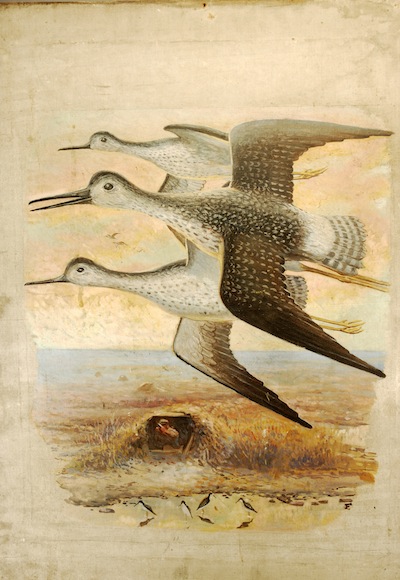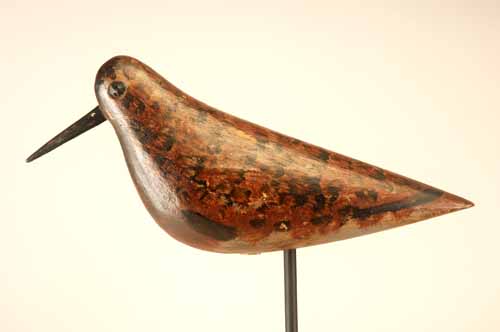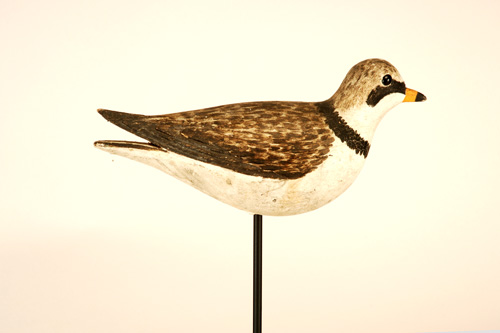Shorebirds: What Are They? Why Collect Them?
Author: Russ & Karen Goldberger
Published: Thu, Mar 22nd, 2012
 What are shorebirds? Why were they hunted? Why collect shorebird decoys?
What are shorebirds? Why were they hunted? Why collect shorebird decoys?
Shorebirds
Shorebirds, also known as beach birds, are a family of different species of water birds with thin bills and skinny legs. They frequent tidal beaches. Their feet are rarely webbed and have separate toes which allow them to distribute their weight and walk on beach sand without sinking. They forage for grubs, insects, plant matter, small vertebrates and mollusks along the sea shore, tidal marshes and wetlands.
Shorebirds range in size from tiny "peeps" (about the size of a sparrow) to curlews (larger than some ducks). They frequent the flyways of North America, particularly the Atlantic Coast, although they are found on the West Coast and inland in the Midwest.
Used by permission
Hunting Shorebirds, Using Decoys
Most species of shorebird were hunted for sport and food. Hunting was particularly heavy from New England through the Southeast during the 19th and early 20th centuries.
Changes in human habitation caused new demand for food supplies. During the Industrial Revolution and immediately following the Civil War, many families relocated from farms to cities. This was particularly noteworthy in the large population centers of the Northeast. People had to be fed.
As the need grew, market hunters and fisherman became primary suppliers. They shipped vast quantities of local game, waterfowl, fish, and shorebirds  to Eastern markets. Railroads were well-developed through the area, making it possible to bring iced fresh game into areas such as Boston, New York, and Philadelphia, where it was sold to restaurants or directly to families.
to Eastern markets. Railroads were well-developed through the area, making it possible to bring iced fresh game into areas such as Boston, New York, and Philadelphia, where it was sold to restaurants or directly to families.
Throughout this period, use of decoys was part of a hunter's practice. Individual hunters and factories usually made shorebird decoys from painted wood, but also paper mache, tin, leather, etc.
 Most species were made, although shorebirds will generally decoy to any species. American shorebird decoys rarely have legs; they were placed on sticks which were pressed into the beach sand. The decoys were effective (too effective!).
Most species were made, although shorebirds will generally decoy to any species. American shorebird decoys rarely have legs; they were placed on sticks which were pressed into the beach sand. The decoys were effective (too effective!).
Unlike other waterfowl, many species of shorebirds are very small, so why shoot them? Shorebirds decoy easily, making them easy targets. Large flocks could be shot at once. There was just enough breast meat on each one to justify killing them for food. The impact of large-scale hunting on shorebird populations was felt quickly; they were disappearing.
Protecting Shorebirds, Rarity of Older Decoys
 In 1918, recognizing the impact of indiscriminate hunting on shorebird populations, the Federal Migratory Bird Treaty Act was passed by the U.S. Congress and signed into law by President Woodrow Wilson. It banned the hunting of most shorebird species in the United States. Ten years later, hunting of two remaining shorebird species (yellowlegs and plovers) was prohibited.
In 1918, recognizing the impact of indiscriminate hunting on shorebird populations, the Federal Migratory Bird Treaty Act was passed by the U.S. Congress and signed into law by President Woodrow Wilson. It banned the hunting of most shorebird species in the United States. Ten years later, hunting of two remaining shorebird species (yellowlegs and plovers) was prohibited.
American shorebird decoys were of no use, once hunting was banned. No one collected decoys, and so most were burned or relegated to burlap sacks in barns or hunting shacks where they rotted or were thrown away. Few survived.
Why Collect Shorebird Decoys
Now, nearly 100 years later, shorebird decoys are actively sought by most decoy collectors. Why?
• They represent an important part of American waterfowl hunting and decoy history.
 • They are beautiful, delicate, and make a wonderful mantel or window display that complements other waterfowl decoys.
• They are beautiful, delicate, and make a wonderful mantel or window display that complements other waterfowl decoys.
• They are rare. Many are over 100 years old, and their delicacy makes them vulnerable to breakage.
• Collectors of regional or factory (duck) decoys can find highly collectible examples by name makers or equally attractive examples by unknown hunters. Shorebird decoys come in a wide variety of species, plumages, regions, and makers, available in many price ranges.
Shorebird Buyer Advice
Collect examples that are 100 or more years old, unless you want to acquire some fine contemporary interpretations. Make sure the dealer or auction house authenticates and guarantees the age of your choices.
 Ideally, buy shorebird decoys in original paint with their original bills. Bills are the most delicate part of a shorebird decoy and subject to breakage. A premium is placed on shorebirds in their original paint with their original bills. A replaced bill should be reflected in the decoy's reduced price.
Ideally, buy shorebird decoys in original paint with their original bills. Bills are the most delicate part of a shorebird decoy and subject to breakage. A premium is placed on shorebirds in their original paint with their original bills. A replaced bill should be reflected in the decoy's reduced price.
Buy what appeals to you regardless of who made it. Many fine shorebird decoy examples are by unknown makers who made only a small rig for their own use.
There are many outstanding contemporary carvers who offer exquisite examples. These are highly collectible, but be sure you buy them as modern recreations, not antiques.
Visit RJG's Shorebirds, Mason Shorebirds, and Contemporary Carvers pages for shorebird decoys currently available for purchase. The decoys used to illustrate this article are not for sale.

Back to articles
